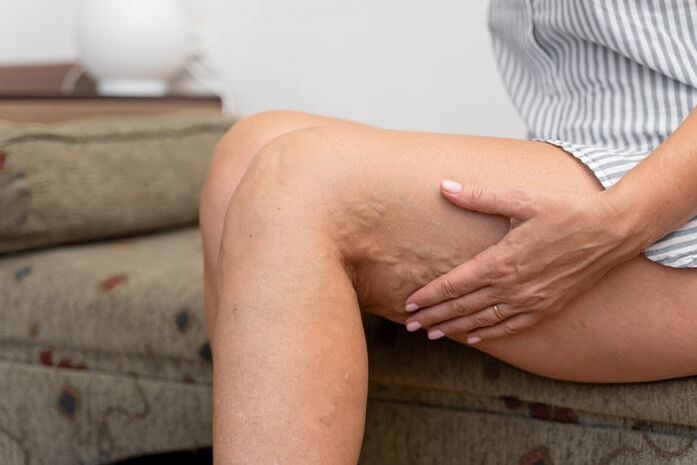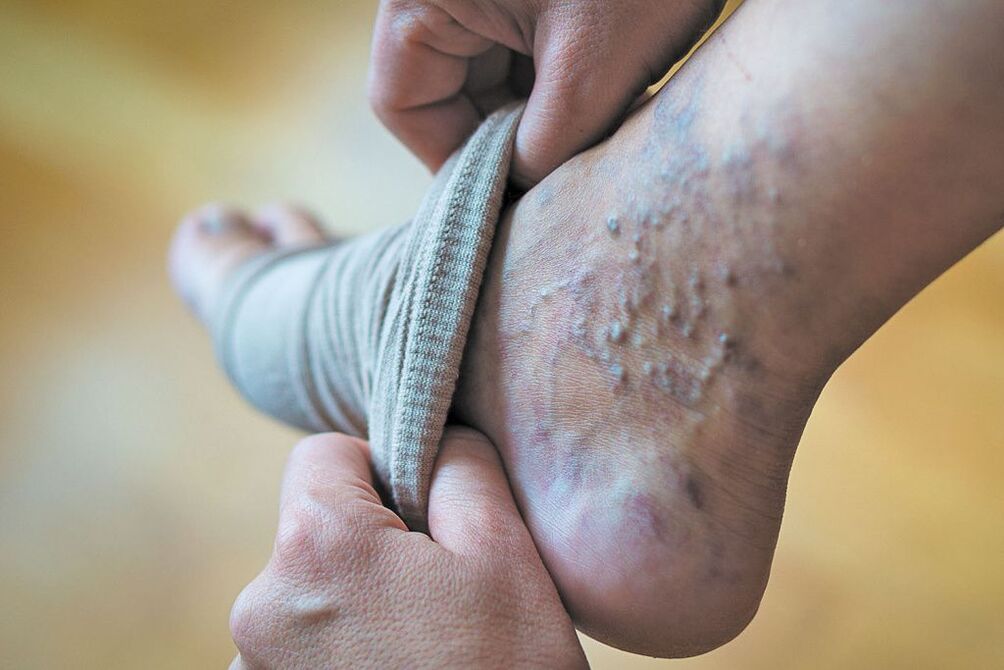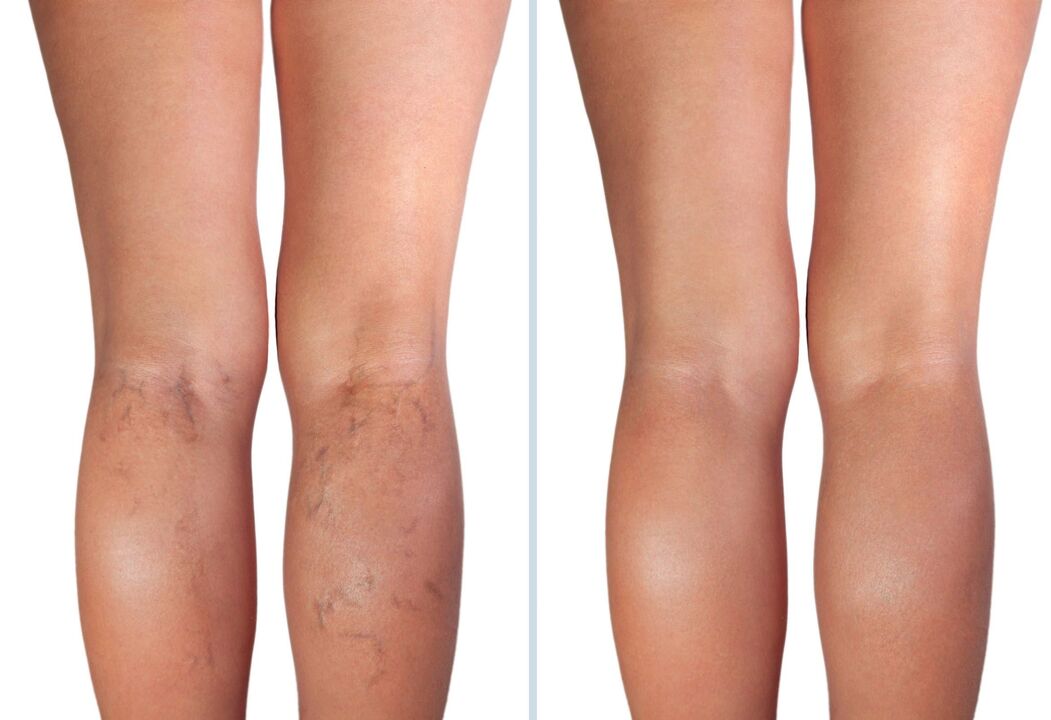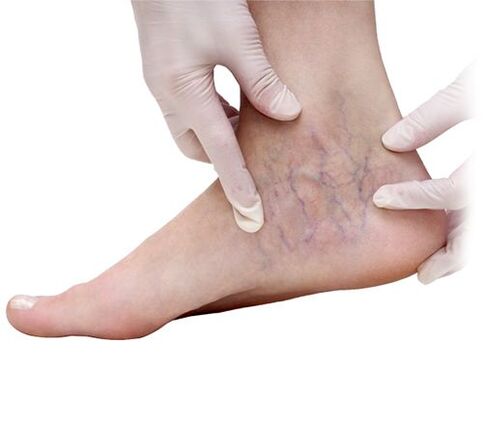
Varicose veins, varicose veins, varicose veins(from Latin varix, varicis - dilated, swollen veins)- Persistent irreversible changes in the veins, characterized by:
- irregular increase in the lumen and length of the veins,
- the formation of nodes in areas of thin veins due to pathological changes in the walls of the veins, thinning, stretching, reducing their tone and elasticity,
- impaired function of venous valves and impaired blood flow.
Varicose veins are a fairly common disease. Varicose veins and its complications are diagnosed in 25% of the population, with women suffering from the disease 2-3 times more often than men. In women, the first signs of the disease are often observed at a young age, often associated with pregnancy and childbirth. At older ages, the incidence increases in both men and women, and the frequency of complicated forms also increases. At age 70, the disease occurs 6-10 times more often than at age 30. However, recently, varicose veins are often observed in very young people, even teenagers. Therefore, identifying all possible causes and preventing venous disorders is becoming an increasingly urgent task.
How do varicose veins arise and develop?
To understand how varicose veins occur, let's briefly explain the physiology of the venous system in the lower limbs. Venous flow in the legs is provided by two interconnected mechanisms - central and peripheral. Central mechanisms involve the heart, lungs, diaphragm, and peripheral mechanisms are directly related to the activity of the venous system of the lower limbs surrounding the vessels of muscles and tissues.
Initial signs of varicose veins are impaired capillary circulation, swelling, a feeling of heaviness in the legs, and the appearance of spider veins and varicose veins. These changes are reversible, but if timely preventative measures are not taken, problems will increase.
As a rule, more than a year passes from the initial signs of varicose veins in the lower limbs to the formation of varicose nodes and the appearance of pronounced symptoms of varicose veins. Developing gradually, varicose veins lead to impaired blood flow and chronic venous insufficiency. Stagnation of blood in the veins can lead to phlebitis (phlebitis), thrombophlebitis (phlebitis with the formation of blood clots), thrombosis (thrombosis with further inflammation in the veins), non-healing dermatitis (phlebitis). skin), trophic ulcers.
Types and forms of varicose veins

There are primary (true) and secondary (symptomatic) varicose veins.
Primary varicose veins are an independent disease of the venous system (varicose veins). It developed gradually over several years. Most often, dilatation of the great saphenous vein is observed (70-85%), less often - the small saphenous vein (5-12%). With varicose veins, 50-70% of vein damage is on both sides.
Secondary varicose veins are symptoms and consequences of diseases in which there is obstruction of blood flow through the deep veins of the lower limbs (post-thrombotic diseases, tumors, scars, inflammatory processes, aplasia and dysplasia). products of deep veins, arteriovenous fistulas, etc. ). Secondary varicose veins are quite rare.
Typically, varicose veins affect the saphenous veins of the lower extremities, which are part of the greater saphenous vein system. Branches of the small saphenous vein are less susceptible to varicose veins.
Classification of types of varicose veins
Until recently in our country, doctors classified varicose veins according to many classifications. V. S. Savelyev's staged clinical classification was used, which reflects the degree of disorders of venous circulation in the limbs and the body's ability to fight these disorders and compensate for them, as well as classification according toVaricose veins and complications they cause.
But the main one today is the international CEAP classification, based on clinical features (C - Clinic), etiology (E - etiology), anatomy (A - anatomy) and pathogenesis features (P -pathogenesis) of the disease.
The 6 clinical grades ("C") are arranged according to increasing disease severity from telangiectasia (TAE) to trophic ulcers.
The cause ("E") part indicates whether the process is primary or not.
The anatomical part of the classification ("A") divides the venous system of the lower extremity into 18 relatively distinct segments, helping to locate the affected area of the venous system.
The pathophysiology ("P") portion characterizes the presence of reflux and/or obstruction within the affected venous segment.
Symptoms of varicose veins

Symptoms of varicose veins depend on the stage of the disease, i. e. about the degree of vascular changes and disruption of the venous system. Depending on the stage, a prognosis about the further development of the disease can be given.
The first stage of varicose veins - grade 1 varicose veins
In the early stages, when venous disease is not clearly evident, there may be no obvious signs of varicose veins. Patients complain of a feeling of heaviness and discomfort in the legs, getting tired too quickly, a feeling of heat, paresthesias (numbness, burning, tingling). Symptoms are aggravated at the end of the day, as well as under the influence of heat - in summer or when wearing warm shoes indoors in winter. Swelling appears in the feet and ankles, disappearing after a short period of rest. Sometimes there can be cramps at night in the calf muscles, but patients attribute this to overwork.
After prolonged physical activity, the veins swell and their webs can be easily seen through the skin. They are especially noticeable in the thighs, legs, and feet. The number of such veins and the degree of their expansion may vary. These may be single and unnoticeable formations on the lower legs, appearing more clearly in the evening or after physical activity. Also at this stage of varicose veins, the appearance of spider veins is observed.
If at this stage you start the simplest conservative treatment as well as follow preventive measures, it is possible to prevent the development of the disease by eliminating most of the symptoms.
Symptoms of grade 2 varicose veins, compensation phase
At this stage of the disease, changes in large blood vessels under the skin become noticeable. The veins are deformed, swollen, blood flow is interrupted, and visible swelling appears in the feet and ankles. Swelling increases with prolonged physical activity in the legs, but resolves after a night's rest. At night, cramps in the calf muscles often occur. Paraesthesia may be seen - temporary loss of sensation in the legs, numbness in the legs, burning sensation, "goosebumps". As the disease progresses, pain appears, gradually increasing in the evening.
This compensation phase, as a rule, lasts several years, and at this time the development of the disease can also be stopped if treatment is started in time. Otherwise, the disease will certainly progress to a more severe stage.
Symptoms of grade 3 varicose veins - decompensation stage
At this stage of varicose veins, symptoms increase significantly, pain and heaviness in the legs become more intense and there is a disturbance in peripheral blood and lymph circulation (chronic venous insufficiency). The swelling does not go away even after a long rest and spreads down the leg. The patient feels uncomfortable because of itchy skin. Foot skin becomes dry, loses elasticity, the skin is easily damaged, and loses the ability to regenerate quickly, causing wounds to heal slowly. Brown spots appear on the skin, usually on the inner surface of the lower part of the legs (hyperpigmentation due to subcutaneous hemorrhage).
All these complaints are constant. In the future, symptoms of pain in the heart area, difficulty breathing, headaches and impaired musculoskeletal function of the affected limb may appear.
Although the decompensation stage is already a very significant manifestation of the disease, with appropriate treatment, the patient's condition can be maintained at a satisfactory level for quite a long time, maintaining the ability to work andPrevent progression to complications.
Grade 4 varicose veins - stage of complications
This stage of the disease is characterized by pronounced disorders of venous circulation. Leg swelling is almost constant, skin itching is increasing, and nutritional disorders appear in the skin under the legs. Progressive varicose veins are often accompanied by eczema, dermatitis and long-term wounds, and because the regenerative capacity of varicose skin is markedly reduced, even a small wound can developinto persistent trophic ulcers. The skin is thin and the vein walls are easily damaged, leading to heavy bleeding. Soft tissues become damaged and open sores become gateways for infection.
The most common complications of varicose veins:
- phlebitis - inflammation of the veins;
- thrombosis - the formation of a blood clot (thrombus) in a vein, which can lead to blockage of the vessel;
- Nutritional ulcers - are formed where the affected veins cannot provide a sufficient amount of blood flowing from the skin, as a result of which nutrition (nutrition) of the tissues is interrupted.
Varicose veins may be complicated by acute thrombophlebitis (sometimes purulent),dermatitis and eczema, bleeding, erysipelas, lymphangitis.One of the most dangerous complications of varicose veins is pulmonary embolism, which can lead to sudden death.
At this stage it is no longer possible to restore the condition of the venous system; we can only talk about preventing further complications and, to the extent possible, improving the patient's quality of life.
Causes of varicose veins
There is no single cause of primary varicose veins of the lower extremities. The development of this disease is often provoked by a number of factors. But all painful symptoms of varicose veins are associated with structural changes in the tissue of the venous walls of blood vessels and disruption of the functioning of venous valves.
What causes these violations?
You can often come across the saying that one of the most important physiological causes for the development of a disease such as varicose veins is an upright posture. Indeed, in humans, by nature, the load on the vascular system of the lower limbs is very high. The flow of blood from the veins and blood to the heart is blocked by the pressure caused by gravity, as well as the high pressure in the abdominal cavity. However, not everyone gets varicose veins. What factors stimulate the development of varicose veins?
It has been established that the main risk factors for the development of varicose veins are:
- hereditary (inherited) predisposition - congenital weakness of vein walls, rupture of venous valves;
- female gender - women suffer from varicose veins 4-6 times more than men;
- Hormonal disorder;
- hormonal contraception;
- pregnancy, especially multiple pregnancy;
- heavy physical activity (heavy physical work, strength sports);
- conditions and diseases that lead to increased intra-abdominal pressure (chronic respiratory disease, constipation, etc. )
- diseases that negatively affect blood vessels (high blood sugar, diabetes, hypertension, etc. );
- work characteristics - standing or sedentary work, sudden temperature changes, prolonged exposure to high or low temperatures;
- overweight, obesity, increases tension in the legs and increases pressure in the pelvic area;
- lack of vitamin C and other beneficial substances necessary for the vascular system;
- Sedentary lifestyle, bad habits destroy blood vessels and put additional stress on them.
Diagnosis of varicose veins

Usually, diagnosing varicose veins is not difficult. Clinical examination, including physical examination (examination and palpation), patient survey, collection of complaints and history (information about the course of the disease, characteristics of life and work, previous diseasesand currently) for severe varicose veins is commonly performed. Diagnosis is possible without the need for instrumental examination. Exceptions are situations when subcutaneous fatty tissue of the lower extremities is so overgrown, it can be difficult to notice changes in varicose veins.
Currently, duplex ultrasound (USDS) has been widely used to study lower extremity veins. This method allows you to determine the location of changes in the veins and the nature of disturbances in venous blood flow. However, you need to know that ultrasound results are largely subjective and largely depend not only on the experience and knowledge of the researcher, but also on the tactical approaches to treating the diseaseveins are applied at a certain medical facility. When determining treatment tactics, they are mainly guided by clinical examination data.
Duplex scanning is performed when planning invasive treatment of lower extremity varicose veins. Additionally, X-ray contrast venography, MRI venography, and CT venography may be used.
All these methods help clarify the location, nature and extent of venous damage, clearly see venous hemodynamic disorders, evaluate the effectiveness of prescribed therapy and predict the evolution of the disease. sick.
Treatment of varicose veins - modern techniques
The main tasks of the doctor in the treatment of varicose veins are:
- eliminate or reduce the severity of symptoms that cause particular discomfort in the patient - pain, swelling, cramps;
- restores and improves the function of blood vessels - from capillaries to deep veins, improves valve function, restores damaged vessel walls, increases their elasticity and strength;
- improves the rheological properties of blood, reduces its viscosity;
- Improves the function of the lymphatic system.
- prevent further development of the disease and complications;
- improve patients' quality of life.
Depending on the stage of the disease and the degree of vascular damage, the doctor can prescribe the most optimal treatment methods for a certain condition, such as:
- conservative treatment– recommendations for prevention and lifestyle changes, pharmacotherapy, compression therapy;
- non-surgical invasive procedure- Sclerotherapy, ultrasound therapy, foam sclerotherapy (Foam therapy), etc. v. ;
- surgery- phlebectomy, thermal cautery, stripping, increasingly complex combined procedures and surgeries for complications of varicose veins and treatment of trophic ulcers of the lower extremities.
These methods help improve blood circulation in the lower limbs, including microcirculation, eliminate many cosmetic defects caused by varicose veins and help the patient get rid of a significant part of painful manifestations. of pathology.
Conservative methods of treating varicose veins
Modern conservative therapy for varicose veins offers an integrated treatment approach and includes several areas:
- lifestyle changes;
- pharmacological therapy;
- compression therapy.
It is no coincidence that changing lifestyle is a top priority. If possible, it is necessary to remove sludge at least to reduce the influence of adverse factors.
One of them is long-term static load in a standing or sitting position leading to blood stagnation. To activate the muscle-venous pump of the lower legs, you need to regularly stretch your legs and walk more. While working, you can periodically perform exercises with alternating contraction and relaxation of the calf muscles (raising your toes).
You should schedule time to participate in outdoor sports that do not involve the risk of leg injury (sports walking or Nordic walking, exercise bike, treadmill, swimming, cycling and walking).
If you have varicose veins, you should not let your feet get too hot, you will have to avoid baths and saunas.
Patients with varicose veins need to monitor their body weight. It is known that with a body mass index of over 27 kg/m22The likelihood of varicose veins increases by 30%. Excess weight is often associated with elevated sugar levels, leading to problems with the healing of venous ulcers and the risk of recurrence.
Compression therapyFor varicose veins, it can be used alone or in combination with pharmaceuticals, as well as after surgery and sclerotherapy.
The effectiveness of compression therapy is explained by its ability to reduce reverse blood flow, reduce some of the pathological possibilities of varicose veins, which leads to reduced swelling, improved capillary blood flow and reduced symptoms of varicose veins. circuit.
In addition to bandages and hosiery, there is also hardware compression therapy, which is especially effective for chronic venous edema and trophic ulcers.
Drug treatment can be recommended in the early stages of varicose veins as the main type of therapy, supplemented, if necessary, with elastic compression. Pharmaceuticals are also prescribed in preparation for surgical treatment or in the postoperative period to speed up recovery and prevent complications.
The following groups of drugs are used to treat venous disease:
- vein tonic and vascular protectant;
- anticoagulants and thrombolytics;
- anti-inflammatory and pain relievers;
- vascular regenerative agent.
For the systemic treatment of varicose veins, venous strengthening and vasoprotective drugs based on bioflavonoids, rutin derivatives, saponins, etc. v. , is mainly used. These drugs increase the elasticity and tone of veins, increase the strength of blood vessels, improve lymph flow and reduce lymphatic pressure. . If there is a risk of thrombosis, anticoagulants will be prescribed. Anti-inflammatory and analgesic drugs are used for complications of varicose veins - phlebitis, severe pain, trophic damage of the veins.
In addition to systemic drugs, topical drugs are used - ointments and gels based on intravenous active substances, heparin, nonsteroidal anti-inflammatory drugs, corticosteroid ointments.
Non-surgical invasive procedure
Treatment of venous sclerosis of the lower limbs
Sclerotherapy is an outpatient medical procedure in which a special substance, a sclerosing agent, is injected into the problem capillary or vein using a thin needle. The vessel is then compressed with a rubber pad or elastic bandage. The vessel walls "stick together", blood flow in the vessel stops. The glued walls often grow back together, leaving scars that will heal on their own. Used to treat varicose veins of small superficial veins. This method is effective in the early stages of the disease, only in cases where varicose veins are localized only in small veins, and allows to eliminate cosmetic defects. A series of treatments may be required to achieve results.
Foam therapy (foam sclerotherapy)
It is distinguished by a special sclerotic substance. Like sclerotherapy, a sclerosing agent is injected into the damaged vein in the form of a fine foam, which quickly "closes" the large affected veins. The method does not require many procedures and brings high results. It is important to know that this procedure - although rare - can have a side effect - visual impairment. Sclerosis that penetrates arteries and nerve tissue is also very dangerous. The procedure should be performed by an experienced phlebologist.
Absolute contraindications to sclerotherapy - allergy to the drug, deep vein thrombosis, pregnancy, breastfeeding
Surgical treatment of varicose veins
As a rule, surgical treatment is recommended in severe, progressive cases and also when conservative methods fail to stop the progression of the disease.
Surgical intervention to treat varicose veins has the following goals
- eliminate cosmetic defects;
- Reduction of subjective symptoms (pain, burning, paresthesia, feeling of heaviness in the legs, etc. );
- prevents deterioration of the saphenous vein;
- prevent bleeding from varicose veins;
- prevention of thrombophlebitis;
- reduces and prevents the development of venous edema;
- reduces manifestations and prevents the development of hyperpigmentation and liposclerosis;
- Accelerates healing and prevents recurrence of venous trophic ulcers.
According to the Clinical Guidelines, the goals of surgical treatment are:
- eliminate pathological vertical and/or horizontal reflux;
- Eliminate saphenous varicose veins.
Before any type of surgery, the risk of developing venous thromboembolic complications (VTEC) is assessed.
There are several surgical methods that can be used depending on the specific situation:
Phlebectomy (phlebectomy) and phlebectomy are safe- traditional operations to eliminate varicose veins.Cut veins- This is surgery to remove diseased vein areas.Surgical excision is safe- a special case of phlebectomy, used in cases of severe and progressive disease. The essence of safe surgical resection is to remove the central trunk of the damaged saphenous vein in a minimally invasive way - through incisions on the vein trunk and insertion of a probe. During this surgery, ligation of the perforating veins is also performed, connecting the saphenous veins to the deep veins.
Short stripping– quickly remove the affected area of the saphenous vein on the thigh or leg through small incisions using a special small thin probe.
Microphlebectomy -removal of varicose veins through puncture of the skin with a needle using a special phlebotomy hook (vein extractor).
Cryosurgery (cryosclerosis)– method of treating venous disease by applying cold compresses (liquid nitrogen) to damaged vessels.
Vein stitching is the placement of multiple stitches on a damaged vein, to stop blood flow through the vessel. As a result, blood clots form and the veins gradually degenerate.
Heat removal method– thermal coagulation and laser coagulationare considered minimally invasive operations.Freezing heat(or RFO - Radiofrequency Vein Obliteration) - exposure to high frequency electric current for a very short period of time, just a split second.Laser coagulation(EVLO or EVLK – endoscopic laser ablation (coagulation) of veins of the lower extremities) - exposure of the laser beam on pathologically dilated vessels. In both cases, due to a local increase in temperature, destruction of the vessel occurs, the so-called "sticking to the wall" or "sealing".
It is important to remember that surgery is not a final cure but rather eliminates symptoms. After surgery, conservative and lifelong treatment is also required and must be explained to the patient.
Depending on the stage of varicose veins, symptoms, comorbidities, and the patient's general health condition, the doctor will make specific recommendations to achieve maximum improvement in the fastest time possible. .

























